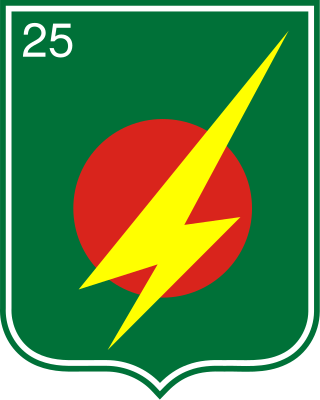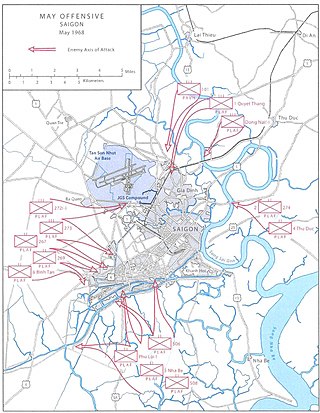
War Zone D was the area in South Vietnam around the Dong Nai River, north of Bien Hoa which served as a Viet Cong (VC) and People's Army of Vietnam (PAVN) base area and infiltration route during the Vietnam War.

War Zone D was the area in South Vietnam around the Dong Nai River, north of Bien Hoa which served as a Viet Cong (VC) and People's Army of Vietnam (PAVN) base area and infiltration route during the Vietnam War.
War Zone D, located in the area designated as III Corps, began approximately 10km north of Bien Hoa. [1] : 28 It comprised southern Phước Long Province, northern Long Khánh Province, northwest Bình Dương Province and northeast Biên Hòa Province. Its northern boundary was Route 14, its western boundary was Route 13 and its southern and eastern boundaries were the Dong Nai River. [2]
Unlike other PAVN/VC bases it was located away from the Cambodian border making it more difficult to supply and lacking the protection afforded by Cambodian neutrality. [1] : 178
War Zone D was the target of a number of early actions by U.S. forces during the Vietnam War as they sought to extend their control out from the greater Saigon area. Shortly after their arrival in South Vietnam, the 173rd Airborne Brigade began their first combat operation on 27 June 1965 with an incursion with Army of Republic of Vietnam (ARVN) forces into War Zone D. [1] : 28 On 7 July troops of Company A, 1st Battalion, 503rd Infantry Regiment walked into an L-shaped ambush in the zone and killed an estimated 50 VC. [1] : 29 From 5-8 November the 173rd Airborne and 1st Battalion, Royal Australian Regiment conducted Operation Hump in the zone. [1] : 76
From 11 February to 2 March 1966 the U.S. 1st Infantry Division conducted Operation Rolling Stone to create a road linking Route 13 with Route 16 and isolate the zone from War Zone C to the west. [1] : 179
The main supply route into the zone was named the Adams Trail which began at Base Area 351 on the Cambodian side of the Phước Long Province border, tunneled its way south through a triple-canopy rainforest, skirted the eastern edge of Sông Bé Province and then passed through the western half of War Zone D. Operated by the 70th Rear Service Group, the trail terminated in northern Biên Hòa Province at a base area known to the Americans as the Catcher's Mitt ( 11°07′16″N106°49′52″E / 11.121°N 106.831°E ). [3] : 46
From 4 December 1967 to 17 February 1968 the U.S. 199th Infantry Brigade conducted Operation Manchester to interdict PAVN/VC supply routes into the zone and keep the PAVN/VC away from Tân Uyên town and the Đồng Nai river hamlets and prevent rocket attacks on Long Binh Post and Bien Hoa Air Base. [3] : 102
A multi-division operation was planned against the zone in 1968, but following the Tet Offensive this was deferred in favor of Operation Quyet Thang. [3] : 460 Operation Toan Thang I and its subsequent operations eventually expanded to cover most of III Corps including the zone. [3] : 464

The Battle of Đồng Xoài was a major battle fought during the Vietnam War as part of the Viet Cong (VC) Summer Offensive of 1965. It took place in Phước Long Province, South Vietnam, between June 9 and 13, 1965.
Biên Hòa is the capital city of Đồng Nai Province, Vietnam and part of the Ho Chi Minh City metropolitan area and located to the northwest of Ho Chi Minh City, to which Biên Hòa is linked by Vietnam Highway 1. Classified as a class-1 provincial city, it is the sixth largest city in Vietnam by population.

The Battle of Phước Long was a decisive battle of the Vietnam War which began on December 12, 1974, and concluded on January 6, 1975. The battle involved the deployment of the People's Army of Vietnam (PAVN) 4th Army Corps for the first time, against determined units of the Army of the Republic of Vietnam (ARVN) in Phước Long in Bình Phước Province near the Cambodian border, under the command of Lieutenant General Dư Quốc Đống.

The Battle of Lộc Ninh was a major battle fought during the Easter Offensive during the Vietnam War, which took place in Bình Long Province, South Vietnam between 4 and 7 April 1972. Towards the end of 1971, North Vietnamese leaders decided to launch a major offensive against South Vietnam, with the objective of destroying Army of the Republic of Vietnam (ARVN) units and capturing as much territory as possible, in order to strengthen their bargaining position in the Paris Peace Accords. On 30 March 1972, two People's Army of Vietnam (PAVN) divisions smashed through the Vietnamese Demilitarized Zone, marking the commencement of the Easter Offensive. They quickly overwhelmed South Vietnamese units in the I Corps Tactical Zone. With the rapid collapse of South Vietnamese forces in the northern provinces of South Vietnam, PAVN and Viet Cong (VC) forces began preparing for their next offensive, targeting Bình Long Province in the rubber plantation region north of Saigon. On 4 April, the VC 5th Division opened their attack on Lộc Ninh, defended by the ARVN 9th Infantry Regiment. After three days of fighting, the vastly outnumbered ARVN forces, though well supported by American air power, were forced to abandon their positions in Lộc Ninh.

The 18th Division was an infantry division in the III Corps of the Army of the Republic of Vietnam (ARVN). The U.S. Military Assistance Command Vietnam considered the 18th as undisciplined and it was well known throughout the ARVN for its "cowboy" reputation. In 1975 the 18th was made famous for its tenacious defense of Xuân Lộc, the last major battle before the Fall of Saigon.

The Vietnamese Rangers, commonly known as the ARVN Rangers, were the light infantry of the Army of the Republic of Vietnam. Trained and assisted by American Special Forces and Ranger advisers, the Vietnamese Rangers infiltrated beyond enemy lines in search and destroy missions. Initially trained as a counter-insurgency light infantry force by removing the fourth company each of the existing infantry battalions, they later expanded into a swing force capable of conventional as well as counter-insurgency operations, and were relied on to retake captured regions. Later during Vietnamization the Civilian Irregular Defense Group program was transferred from MACV and integrated as Border Battalions responsible for manning remote outposts in the Central Highlands.

The Fifth Division of the Army of the Republic of Vietnam (ARVN)—the army of the nation state of South Vietnam that existed from 1955 to 1975—was part of the III Corps that oversaw the region of the country surrounding the capital, Saigon.

The 25th Division of the Army of the Republic of Vietnam (ARVN)—the army of the nation state of South Vietnam that existed from 1955 to 1975—was part of the III Corps that oversaw the region of the country surrounding the capital, Saigon. It was based at Củ Chi Base Camp to the northwest of the city.

The 9th Infantry Division of the Army of the Republic of Vietnam (ARVN)—the army of the nation state of South Vietnam that existed from 1961 to 1975—was part of the IV Corps that oversaw the southernmost region of South Vietnam, the Mekong Delta. The 9th Infantry Division was based in Sa Dec 1962 - 1972 and Vinh Long 1972 - 1975 throughout the war.

Operation Coburg was an Australian and New Zealand military action during the Vietnam War. The operation saw heavy fighting between the 1st Australian Task Force and North Vietnamese People's Army of Vietnam (PAVN) and Viet Cong (VC) forces during the wider fighting around Long Binh and Bien Hoa.

The Vietnamese Airborne Division was one of the earliest components of the Republic of Vietnam Military Forces. The Vietnamese Airborne Division began as companies organized in 1948, prior to any agreement over armed forces in Vietnam. After the partition of Vietnam, it became a part of the Army of the Republic of Vietnam. This division had its distinct origins in French-trained paratrooper battalions, with predecessor battalions participating in major battles including Dien Bien Phu and retained distinct uniforms and regalia. With the formation of an independent republic, the colonial paratroopers were dissolved, however regalia and aesthetics alongside the nickname "Bawouans" would be retained.

Operation Toan Thang I was a U.S. Army, Army of the Republic of Vietnam (ARVN), 1st Australian Task Force and Royal Thai Volunteer Regiment operation conducted between 8 April and 31 May 1968 in the Vietnam War. The operation was part of a reaction to the Tet Offensive designed to put pressure on Vietcong (VC) and People's Army of Vietnam (PAVN) forces in III Corps.

The inauguration of Richard Nixon in January led to a reevaluation of the U.S. role in the war. U.S. forces peaked at 543,000 in April. U.S. military strategy remained relatively unchanged from the offensive strategy of 1968 until the Battle of Hamburger Hill in May which led to a change a more reactive approach. The U.S. and South Vietnam agreed on a policy of Vietnamization with South Vietnamese forces being expanded and equipped to take over more of the ground combat from the departing Americans which began to withdraw in late June without any reciprocal commitment by the North Vietnamese. The morale of U.S. ground forces began to fray with increasing racial tensions and the first instances of fragging and combat refusal. The antiwar movement in the U.S. continued to grow and public opinion turned increasingly antiwar when the Mỹ Lai massacre was revealed in November.
The VC 5th Infantry Division was a division of the Viet Cong during the Vietnam War and later became part of the People's Army of Vietnam.

Operation Silver City was an operation conducted by the 1st Brigade, 1st Infantry Division and the 173rd Airborne Brigade in Biên Hòa Province, lasting from 7 to 23 March 1966.
Operation Quyet Thang, was a United States Army and Army of the Republic of Vietnam (ARVN) security operation to reestablish South Vietnamese control over the areas immediately around Saigon in the aftermath of the Tet Offensive. The operation started on 11 March 1968 and ended on 7 April 1968.
Operation Enterprise was a U.S. Army pacification and security operation that took place in Long An Province, lasting from 13 February 1967 to 11 March 1968.

The attacks on Biên Hòa, Bien Hoa Air Base and Long Binh Post, occurred during the early hours of 31 January 1968 and continued until 2 February 1968. The attacks by Vietcong (VC) and People's Army of Vietnam (PAVN) forces were one of several major attacks around Saigon in the first days of the Tet offensive. The attacks were repulsed with the VC/PAVN suffering heavy losses, having inflicted minimal damage on the bases.
Operation Sheridan Sabre was a security operation during the Vietnam War in Bình Long Province to prevent People's Army of Vietnam (PAVN) infiltration from Cambodia, that took place from 7 November 1968 to 4 April 1969.

The Battle of West Saigon took place from 5–12 May 1968 during the May Offensive of the Vietnam War as South Vietnamese and United States forces countered the main thrust of the offensive against the western suburbs of Saigon.